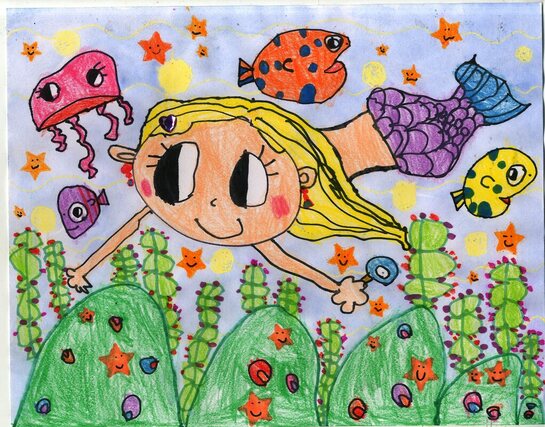Children's Art
CHILDREN’S BEGINNING ART
Age: 3-5 yrs (Pre-K-K)
|
Preschoolers draw their reality and what they know about the world. Rather than attempting to capture a photographic image of reality, this stage of development is dedicated in creating representations using symbols formed with circle, squares, lines, etc., as they associate common objects such as, flowers, trees, sun, cats, etc. This is an introductory stage for creating, challenges, development & expressing ideas. Student use learnt skills, language, techniques, & processes of art making (line, texture, shapes, color mixing, pattern & design recognition, etc.); but most importantly imagination! Here at WCAAD, we encourage open-ended exploration of art materials, self-confidence, & enjoyment in art & learning. Student collaborate & independently explore creating, making, & presenting for a range of audiences. Observation & anecdotal responses, assist students, in various situations where they choose more personal artwork. Eventually children will reach a benchmark where habitual repetition of associative symbols on familiar objects are used as subjects evolving into balance & consideration of a picture as whole. |
|
|
At the end of this stage: The important parts in the pictures are depictions & demonstration of intention. Color-mixing & experimentation, rather than true representation of color & new strategies are achieved to put shapes & object together in an artistic context. Experimentation with various material are included in the lesson plans with a newly discovering and appreciation of learnt criteria; Fine motor skills are honed-in for informed choices, contribute ideas, & directions.
CHILDREN’S CREATIVE ART
Age: 6-8 yrs
|
|
Pictures become more complex & reflect the world in factual, realistic representations. The schema represents the children's active knowledge of the subjects and there is definite order in space relationships: “everything sits on the “base line”. They learn different ways to depict objects, informal drawing and painting, materials & explore techniques. Visual arts are part of their daily life here at WCAAD, & range from drawing, painting, sculpture, & print making, to landscaping, & folk arts, color theory, art appreciation, purpose, space & relation; are few of many topics discussed for better student perspective & analyses. Awareness & use of Design elements in everyday observation are evident to the insights & visual stimuli that is processed & interpreted regularly. They understand that knowledge of the visual arts is necessary to understand design-oriented surrounding space. The main characteristics of this stage is to balance the whole picture & carefully composed compositions are the objectives. Children at this stage start demonstrating stronger focus on drawing in a more realistic fashion. |
CHILDREN’S TRANSITIONAL ART
Age: 9-11yrs
|
Children at this stage may become very frustrated if they are unable to create a realistic picture. This is the time when children may express “I can’t draw.” They are increasingly and critically aware of the immaturity of their drawings and therefore continuously experience frustration at "getting things right." This stage is the crisis period when children are easily discouraged. Those who do manage to survive the crisis and learn the "secret" of drawing will become absorbed in it. With our mentoring, students become much more self- aware, & at this stage, try for more details, hoping to achieve greater realism, and attempt to produce artworks that meets adult standards. Students create art from their own interest with an Introduction to Fundamentals of Art & technology . Demonstrate willingness to experiment, innovate, & take risks to pursue ideas, forms, & meanings that emerge in the process of art or design. Furthermore, through language & skills, students perceive & respond to works of arts, objects in nature, events, and their environments. This is a critical stage for children because they either reach a plateau or enter the stage of realism. |
|
At the end of this stage: Students will enhance hand & eye coordination, fine & gross muscle development & control, demonstrate proficient language unique to Art. Initiating & independently create with a continual enjoyment of the process of art making by choosing from a range of materials and methods of traditional and contemporary artistic practices to plan artwork. Gain a range of various art skills and understanding complex vocabulary with appropriate level through experimentation, practice, & persistence
|
|
|
JR. ADVANCED ART
Age: 12+
After 12 years old children enter adolescence, marking the end of art as spontaneous activity. They strive to create "adult-like" naturalistic drawings with formal foundation. Light and shadow, perspective, three-dimensionality etc. Various studio experiences in the classroom will give students opportunities to experience a variety of media while developing student’s individual style and creative problem-solving skills.
- Critically aware of maturity of their art & describe their own artistic growth over time in relation to specific criteria.
- Formal foundation begun (Sketching, Color theory, Painting /Drawing Digital)
- Life Drawing with anatomy intro with application to artwork
- Research Project based design assignments
- Digital with concentrated project(s)
- Apply visual organizational strategies to design & produce a work that clearly communicates information or ideas.
- Understand the importance of balancing freedom & responsibility in the use of images, materials, tools, & equipment in the creation & circulation of creative work.
- Reach Master level. Produce sophisticated work
- Analyze, select, & curate artifacts &/or artworks for presentation & preservation & critique personal artwork for a collection or portfolio presentation.
- Describe careers & occupations in which knowledge of design principles is important, such as fashion, manufacturing, advertising, web design, etc.
At the end of this stage: Students at this stage will learn the Elements of Art and Principles of Design while developing professional drawing skills, painting techniques, & digital media. Create works that use the elements of art and principles of design to solve specific visual arts problems;
|
|
|

